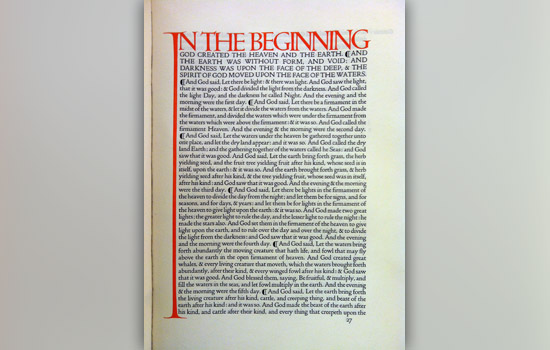RIT marks 400th anniversary of King James Bible
Cary Graphic Arts hosts historical tour of one of the most widely read books in the world
The Doves Press edition of the King James Bible, The English Bible Containing the Old Testament & the New. Hammersmith, England: 1903-1905. Designed to reflect 15th-Century Venetian printing, this Bible has little ornamentation, letting the text speak for itself through an elegant typeface. The type’s designer and founder of Doves Press, T.J. Cobden-Sanderson, is as famous for his type design as what he eventually did with his type. In 1916 he threw his type and the punches and matrices used to make it into the River Thames—a dramatic end to the Doves Press.
Discover the fascinating origins, creation and impact of the 1611 King James Bible as the Cary Graphic Arts Collection at Rochester Institute of Technology commemorates the 400th anniversary of one of the most widely read books in the world.
“Manifold Greatness: The Creation and Afterlife of the King James Bible” is making its final stop through Dec. 13 at the Cary Graphic Arts Collection on the second floor of The Wallace Center at RIT. An opening reception and lecture by Cary Collection curator Steven Galbraith will be held from 5 to 8 p.m. Friday, Sept. 13.
At the center of the retrospective are 14 graphic panels combining narrative text with numerous images of rare books, manuscripts and works of art that highlight the beginnings of the Bible in the English language and culminate in the version of the King James Bible and its influence during the last four centuries.
The exhibition is accompanied by selected artifacts from the Cary Collection—including a King James Bible from 1674 and the Doves Press edition of the King James Bible (1903-1905).
“Originally intended as a revision of translations used by the Church of England, the King James Bible, or Authorized Version, became the most influential English translation of the Bible,” explains Galbraith. “First printed in 1611, it was built upon the struggles of religious reformers who risked their lives by committing the heresy of translating the Bible into English. About four dozen men chosen to work on the King James Bible revised the translations of their predecessors with no idea of how influential and long lasting their results would be.”
Before joining RIT in 2012, Galbraith was co-curator of Manifold Greatness while serving as the Andrew W. Mellon curator of rare books at the Folger Shakespeare Library in Washington D.C.—along with Hannibal Hamlin, associate professor of English at Ohio State University. The panel exhibition is sponsored by the National Endowment for the Humanities, the American Library Association, the Folger Shakespeare Library and the Bodleian Library of the University of Oxford.Galbraith says it’s impossible to tally the number of King James Bible editions printed worldwide since 1611, or to measure its far ranging social, cultural, literary or religious influence.
“One thing we know for sure, authors and poets allude to its passages; composers from Handel to Bob Marley have set its words to music,” says Galbraith. “Animators and visual artists are inspired by its phrases. Presidents often use King James Bibles at their inaugurations and many families still keep records of key events in copies that become family heirlooms.
“The farthest physical reach of the King James Bible to date came on Christmas Eve 1968, when the Apollo 8 astronauts orbiting the Moon read from Genesis in a broadcast heard by half a billion people.”
The Melbert B. Cary Jr. Graphic Arts Collection at RIT is a renowned resource for those studying printing and graphic communications history, bookbinding, typography, papermaking, calligraphy and graphic design. Hours are from 9 a.m. to noon and 1 to 5 p.m. Monday through Friday. For information, call 585-475-3961.














